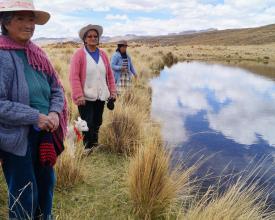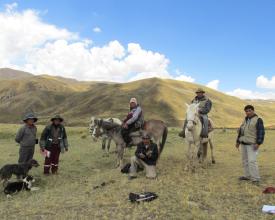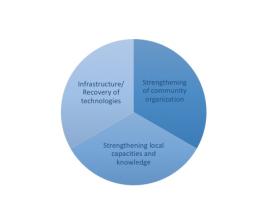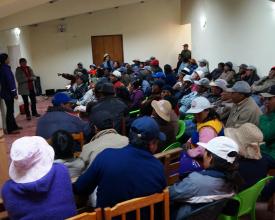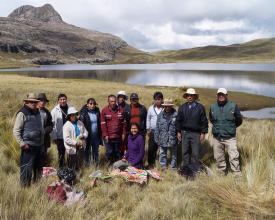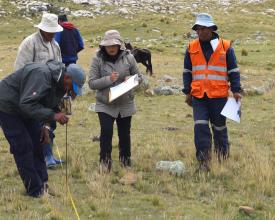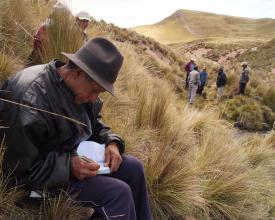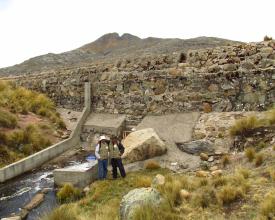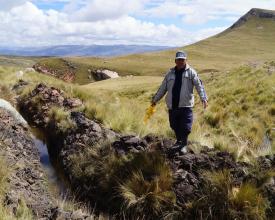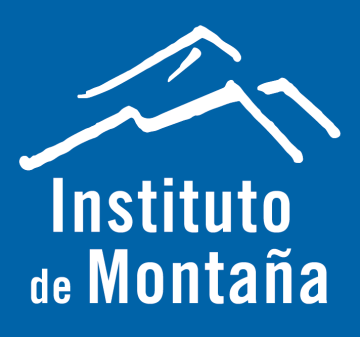
Restauration, conservation et extension des pâturages de montagne et des zones humides et amélioration de la gestion communale à Canchayllo, Pérou

Une mesure d'adaptation basée sur l'écosystème a été mise en œuvre par la communauté de Canchayllo et l'Institut de la montagne en partenariat avec la réserve paysagère Nor Yauyos Cochas et l'UICN. Notre solution d'adaptation combine les connaissances traditionnelles (indigènes) et locales avec les dernières avancées scientifiques et comprend trois composantes : (1) le renforcement de l'organisation communautaire, (2) le renforcement des capacités locales et (3) la combinaison des infrastructures vertes et grises. En collaboration avec des scientifiques et des praticiens, les membres de la communauté de Canchayllo ont décidé de réparer un barrage et de réhabiliter un ancien canal inutilisé.
Cela a permis de rétablir un réseau d'anciens fossés dans les terres agricoles communales et les zones environnantes, qui alimentent désormais en eau 560 hectares de pâturages. En outre, l'eau recharge des étangs temporaires et des aquifères souterrains qui alimentent des puits et des sources dans la partie inférieure du micro-bassin versant de Jaramayo et dans le sous-bassin de Cochas - Pachacayo.
Contexte
Défis à relever
- Faible organisation communale.
- Accès difficile à la zone communale et faible niveau de participation locale au début.
- Méfiance initiale à l'égard du projet.
- Seuls 41 % de la population (principalement des éleveurs de bétail) ont déclaré dépendre directement des services écosystémiques (liés aux pâturages et à l'eau).
- Difficultés à faire correspondre les attentes locales à l'approche EbA en raison d'intérêts contradictoires au sein de la communauté et parmi les autorités (c'est-à-dire les éleveurs de bétail par rapport à ceux qui recherchent des opportunités de revenus alternatifs tels que l'exploitation minière).
Emplacement
Traiter
Résumé du processus
Les éléments constitutifs sont articulés de manière à contribuer à la durabilité de l'initiative. L'infrastructure technologique, combinée à des activités visant à renforcer les capacités techniques et organisationnelles, jette les bases d'une mise en œuvre et d'une maintenance durables de la mesure.
- Renforcement de l'organisation communautaire
- Renforcement des capacités et des connaissances locales
- Infrastructure/ récupération des technologies
Blocs de construction
Renforcement de l'organisation communautaire
Dans le cadre du volet "Renforcement de l'organisation communautaire", un plan de gestion a été élaboré pour promouvoir la gestion intégrée des pâturages, de l'eau et du bétail sur l'ensemble du territoire communal de Canchayllo. L'objectif était de renforcer l'organisation communautaire afin que l'eau puisse être distribuée plus efficacement et que les zones de pâturage puissent bénéficier d'une meilleure rotation. Le processus d'élaboration du plan de gestion a été facilité par l'Institut de la montagne, qui a utilisé une méthodologie visant à renforcer les capacités et à stimuler les pratiques collectives et sociales au sein de la communauté. Le plan est défini comme un ensemble d'idées qui émergent d'une population donnée au moyen d'un processus d'analyse approfondi basé sur leurs propres perspectives. Le plan de gestion peut également servir d'outil de gestion locale à moyen terme.
Selon le vif intérêt de cette communauté, l'analyse et la planification se sont concentrées sur les prairies et l'eau. Le plan a également encouragé la communauté à créer un comité chargé d'entretenir et d'exploiter les infrastructures hydrauliques rénovées afin que l'eau continue de couler et que les prairies continuent d'être irriguées. En outre, un document contenant des recommandations techniques a été élaboré pour la gestion des prairies communales.
Facteurs favorables
- Échange de connaissances locales et scientifiques : participation et échange entre experts locaux et externes.
- Approche participative et méthodologie de recherche-action participative.
- Engagement des partenaires communaux.
- Relation saine et travail coordonné entre l'Institut de la montagne et la réserve paysagère Nor Yauyos-Cochas/Service péruvien des zones naturelles protégées (SERNANP).
- La communication comme élément central.
- Intérêt des agriculteurs.
- Soutien constant par l'intermédiaire d'un facilitateur.
Leçon apprise
- Une bonne évaluation de la composante sociale est essentielle dans le diagnostic, y compris l'analyse de la situation actuelle, mais aussi des conflits passés et présents, ainsi que des tensions et des tendances. Il est également conseillé d'accorder une attention particulière aux activités existantes qui sont incompatibles avec l'approche EbA ou avec d'autres mesures prévues.
- Il faut consacrer suffisamment de temps aux dimensions socio-économiques, politiques et culturelles, en plus des aspects biophysiques (qui reçoivent souvent le plus d'attention). La gouvernance locale, y compris la cartographie et l'analyse des conflits passés et présents au sein de la communauté, la dépendance directe à l'égard des services écosystémiques et le type de gestion du territoire dans les domaines spécifiques des mesures présélectionnées sont tout aussi importants.
- Une bonne compréhension de la prise de décision concernant la gestion des ressources dans une zone spécifique est essentielle. Il peut s'agir d'un conseil communautaire, d'une ou plusieurs familles, d'une association au sein de la communauté, etc.
Renforcer les compétences et les connaissances locales
Dans le cadre du volet "Renforcement des compétences et des connaissances locales", nous avons organisé des cours et des ateliers, facilité des discussions et dirigé des formations sur l'application des techniques de récupération des pâturages et l'évaluation de leur efficacité. Ces activités ont permis de sensibiliser les agriculteurs de la communauté et de les inciter à créer de nouveaux petits projets tels que la clôture et la récupération des pâturages ou la gestion de l'eau et du bétail. En outre, le système de suivi appliqué montre que les compétences en matière de gestion des pâturages, en ce qui concerne l'évaluation, la pose de clôtures et la récupération au niveau familial et communautaire, ont augmenté (IM, UICN, 2015). Dans le cadre des activités de communication, une vitrine d'information et deux vidéos participatives, une pièce de théâtre et des publications ont été produites. Cela a contribué à sensibiliser le groupe d'éleveurs aux pâturages, à l'eau et à la gestion du bétail et a permis de diffuser des informations sur le projet au niveau de la communauté et de la réserve paysagère (IM, UICN, 2015). Les informations ont été générées par des diagnostics ruraux participatifs (études spécifiques sur l'eau, les pâturages, l'archéologie, l'organisation sociale, les activités productives) et une étude hydrogéologique dans la zone d'influence du canal d'eau.
Facteurs favorables
- Utilisation d'outils de communication pour accroître la sensibilisation et la compréhension du projet au niveau local.
- Dialogue et échange de connaissances entre les experts locaux et externes.
- La communication est un élément central.
- Soutien constant par l'intermédiaire d'un facilitateur.
- Les chercheurs locaux ont servi de pont entre le projet et l'ensemble de la communauté.
Leçon apprise
- Planifier les activités de communication comme une question transversale du projet.
- Inclure des activités qui impliquent les groupes de la communauté susceptibles d'être sous-représentés. Par exemple, les vidéos participatives, les pièces de théâtre et les activités artistiques sont particulièrement adaptées pour transmettre des messages aux jeunes, aux femmes, aux enfants et aux personnes âgées.
- Il est utile de disposer d'une équipe formée à l'application d'une approche participative, à l'utilisation d'outils participatifs et à la facilitation de l'apprentissage collectif.
- Diversifier les méthodes avec les partenaires locaux, en combinant les ateliers avec d'autres méthodes et outils plus pratiques et basés sur le terrain ("apprendre par la pratique").
- Concevoir et mettre en œuvre une stratégie de communication qui contribue à diffuser les résultats intermédiaires du projet. Il peut s'agir d'outils de communication très attrayants et percutants, tels que des vidéos participatives, des pièces de théâtre ou des "nuits de l'art".
- Maintenir un niveau élevé de présence sur le terrain et partager la vie quotidienne avec la communauté.
Récupération des technologies et des infrastructures vertes et grises
Dans le cadre du volet "Récupération des technologies et des infrastructures vertes et grises", le barrage de Chacara a été réparé et un ancien canal d'eau inutilisé a été remis en état. Cela a permis de récupérer un réseau d'anciens fossés dans les terres agricoles communales et dans les zones élevées de Yanaututo et Pumapanca. Ces zones alimentent en eau 560 ha de pâturages (Hidroandes, 2015). En outre, l'eau recharge des étangs temporaires et des aquifères souterrains qui alimentent des puits et des sources dans la partie inférieure du micro-bassin versant de Jaramayo et le sous-bassin de Cochas - Pachacayo (Idem, 2015). Une zone pilote de 3 ha a été clôturée pour protéger les pâturages pendant qu'ils se rétablissent. Elle est surveillée par l'administration de la réserve paysagère avec le soutien de la communauté. La communauté a également contribué à la main d'œuvre pour les activités de cette composante.
Facteurs favorables
- Un engagement fort de la part de la communauté qui a contribué à hauteur de 45% du coût par le biais de la main d'œuvre, des matériaux, de l'équipement et de la machinerie.
- Les recherches locales ont permis d'établir un lien entre le projet et les communautés.
- Engagement des autorités communales.
- Relations saines et travail coordonné entre l'Institut de la montagne et la réserve paysagère Nor Yauyos-Cochas/Service péruvien des zones naturelles protégées (SERNANP).
- Soutien constant par l'intermédiaire d'un facilitateur.
Leçon apprise
- Orienté vers la demande : La sélection des mesures doit répondre aux priorités et aux intérêts locaux (en cohérence avec l'approche EbA).
- Prendre en compte le pourcentage de la population bénéficiant directement de (certains) services écosystémiques comme critère de sélection.
- Prévoir suffisamment de temps pour les mesures d'infrastructure, en particulier dans les zones au relief accidenté et au climat extrême, typiques des zones de haute montagne, et en particulier lorsque la main-d'œuvre locale/le travail communautaire en fait partie intégrante. Veillez à ce que le temps nécessaire à la construction corresponde au calendrier du projet.
- Réserver un temps de réflexion pendant la phase de mise en œuvre afin de prendre des mesures qui renforcent les effets positifs.
- Rechercher l'engagement et le soutien des autorités/responsables locaux et les impliquer dans les processus décisionnels clés. Établir des partenariats avec les gouvernements locaux, ce qui contribuera à rendre l'initiative durable.
Impacts
La capacité de stockage de l'eau de la zone communautaire s'est améliorée grâce aux réparations effectuées sur le barrage du lac Chacara. En septembre 2015, un débit de 184 litres par seconde a été enregistré. La réhabilitation du canal principal Chacara-Jutupuquio (2 855 m) a permis d'augmenter la disponibilité de l'eau dans la partie supérieure de la communauté. Des zones humides et des cuvettes se sont formées et un canal ancestral a été récupéré dans la zone gérée collectivement. Ce canal restauré - une combinaison d'une canalisation en PVC et de fossés d'infiltration avec des fonctions de distribution et de régulation de l'eau - fournit de l'eau à 560 hectares de pâturages indigènes et de secteurs de pâturage.
La probabilité d'incendies a été réduite en raison de l'humidité plus élevée dans les pâturages. Les observations d'oiseaux, tels que les canards(Anas flavirostris), ont augmenté. On peut les apercevoir dans les lagunes ou les qochas (étangs naturels) temporaires, formés par l'eau qui s'écoule dans le canal restauré et le système de fossés. Trois hectares de pâturages indigènes ont été restaurés de manière naturelle grâce à des parcelles de démonstration.
Bénéficiaires
- Directement : 60 familles liées à l'élevage dans la communauté rurale de Canchayllo.
- Indirecte : 150 familles (environ 700 personnes) dans la communauté de Canchayllo et la population vivant dans la partie moyenne et inférieure du bassin versant.
Objectifs de développement durable
Histoire
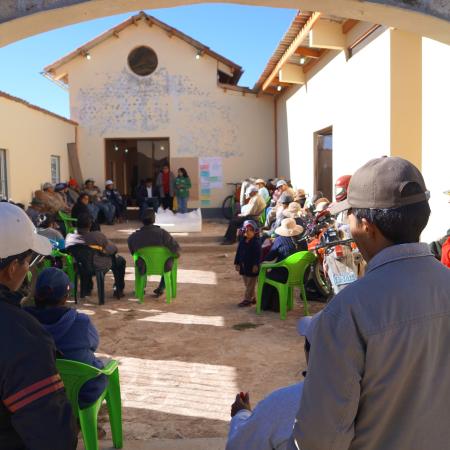
Témoignage de Gonzalo Quiroz - Responsable de la réserve paysagère de Nor Yauyos-Cochas
Contrairement à d'autres projets qui sont accompagnés d'une formule préétablie et qui disent "je dois faire A, B, C, D et voici mes indicateurs et mes résultats", je pense que l'un des avantages de ce projet réside dans le fait qu'il a été possible de le concevoir pendant la durée du mandat. Contrairement à d'autres projets où tout est prévu au départ et où l'on se dit "je dois faire ceci et je ne peux même pas changer le nom de l'activité", je pense que c'est l'un des avantages de ce projet.
Je pense que c'est l'un des aspects positifs de ce projet. [...] C'est une question d'appropriation, n'est-ce pas ? Il ne s'agit pas d'un processus de construction parallèle ou d'un projet développé par l'un sans l'intervention de l'autre. Je pense qu'il s'agit d'un processus de planification commun qui se reflète dans le plan directeur et dans les activités qui ont été mises en œuvre.
Nous (la réserve paysagère Nor Yauyos-Cochas et l'Institut de la montagne) nous sommes alignés l'un sur l'autre et je ne pense pas qu'il s'agisse d'un mandat, d'un ordre. Il s'agissait d'un avantage mutuel, car nous sommes deux institutions qui interviennent sur le même territoire. La logique veut que nous nous soutenions mutuellement parce qu'en fin de compte, ces activités sont mises en œuvre au profit de la population, et non des institutions. [...]
Idéalement, nous formons une seule équipe et je pense que cela a fonctionné, car nous avons lancé les appels et les invitations dans un langage commun. Les deux institutions ont signé une lettre d'invitation et votre personnel [The Mountain Institute] et le nôtre [Nor Yauyos-Cochas Landscape Reserve] ont contribué à assurer l'appel, ont participé aux ateliers, ont participé aux activités [...]. Il ne s'agit donc pas d'un processus d'ordres au début et d'habilitation à la fin, mais d'un processus que nous avons conçu et mené à bien ensemble dans un but commun. En tant qu'institution, nous mettons en œuvre cet objectif commun.
Si je dois travailler sur la question de la restauration de l'écosystème pour améliorer la récolte de l'eau, il me faudra au moins trois ou quatre ans pour mettre en place l'infrastructure, gérer les pâturages, sensibiliser les gens à la mise en œuvre de cette gestion et voir comment cet écosystème ou ce service écosystémique qui fait partie du pâturage, qui est le fourrage, commence à améliorer la qualité de vie de la population".

